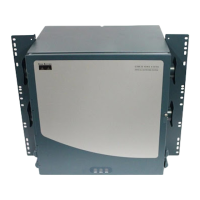6-12
Cisco ONS 15454 Procedure Guide, R5.0
August 2005
Chapter 6 Create Circuits and VT Tunnels
NTP-A182 Create a Manually Routed DS-1 Circuit
• Create cross-connects only (TL1-like)—Check this box if you want to create one or more
cross-connects to complete a signal path for TL1-generated circuits. Also, VT tunnels and
Ethergroup sources and destinations are unavailable.
• State—Choose the administrative state to apply to all of the cross-connects in a circuit:
–
IS—Puts the circuit cross-connects in the IS-NR service state.
–
OOS,DSBLD—Puts the circuit cross-connects in the OOS-MA,DSBLD service state. Traffic is
not passed on the circuit.
–
IS,AINS—Puts the circuit cross-connects in the OOS-AU,AINS service state and suppresses
alarms and conditions. When the connections receive a valid signal, the service state
automatically changes to IS-NR.
–
OOS,MT—Puts the circuit cross-connects in the OOS-MA,MT service state. The maintenance
state does not interrupt traffic flow; it suppresses alarms and conditions and allows loopbacks
to be performed on the circuit. Use OOS,MT for circuit testing or to suppress circuit alarms
temporarily. Change the administrative state to IS; IS,AINS; or OOS,DSBLD when testing is
complete. See the “DLP-A230 Change a Circuit Service State” task on page 19-19.
For additional information about circuit service states, refer to the “Circuits and Tunnels” chapter
in the Cisco ONS 15454 Reference Manual.
• Apply to drop ports—Check this check box if you want to apply the administrative state chosen in
the State field to the circuit source and destination ports. CTC applies the administrative state to the
ports only if the circuit bandwidth is the same as the port bandwidth or, if the port bandwidth is
larger than the circuit, the circuit must be the first circuit to use the port. If not, a Warning dialog
box displays the ports where the administrative state could not be applied. If the check box is
unchecked, CTC does not apply the administrative state of the source and destination ports.
Note Loss of signal alarms are generated if ports in the IS-NR service state are not receiving
signals.
• Protected Drops—Check this box if you want the circuit routed on protected drops only, that is, to
ONS 15454 cards that are in 1:1, 1:N, 1+1, or optimized 1+1 protection. If you check this box, CTC
shows only protected cards and ports as source and destination choices.
Step 8 If the circuit will be routed on a path protection, complete the “DLP-A218 Provision Path Protection
Selectors” task on page 19-12. Otherwise, continue with the next step.
Step 9 Click Next.
Step 10 Complete the “DLP-A95 Provision a DS-1 Circuit Source and Destination” task on page 17-96.
Step 11 In the Circuit Routing Preferences area (Figure 6-2 on page 6-9), uncheck Route Automatically.
Step 12 To set the circuit path protection, complete one of the following:
• To route the circuit on a protected path, leave Fully Protected Path checked and continue with
Step 13. Fully protected paths might or might not have path protection path segments (with primary
and alternate paths), and the path diversity options apply only to path protection path segments, if
any exist.
• To create an unprotected circuit, uncheck Fully Protected Path and continue with Step 16.
• To route the circuit on a BLSR protection channel, if available, uncheck Fully Protected Path,
check Protection Channel Access, click Ye s in the Warning dialog box, then continue with Step 16.

